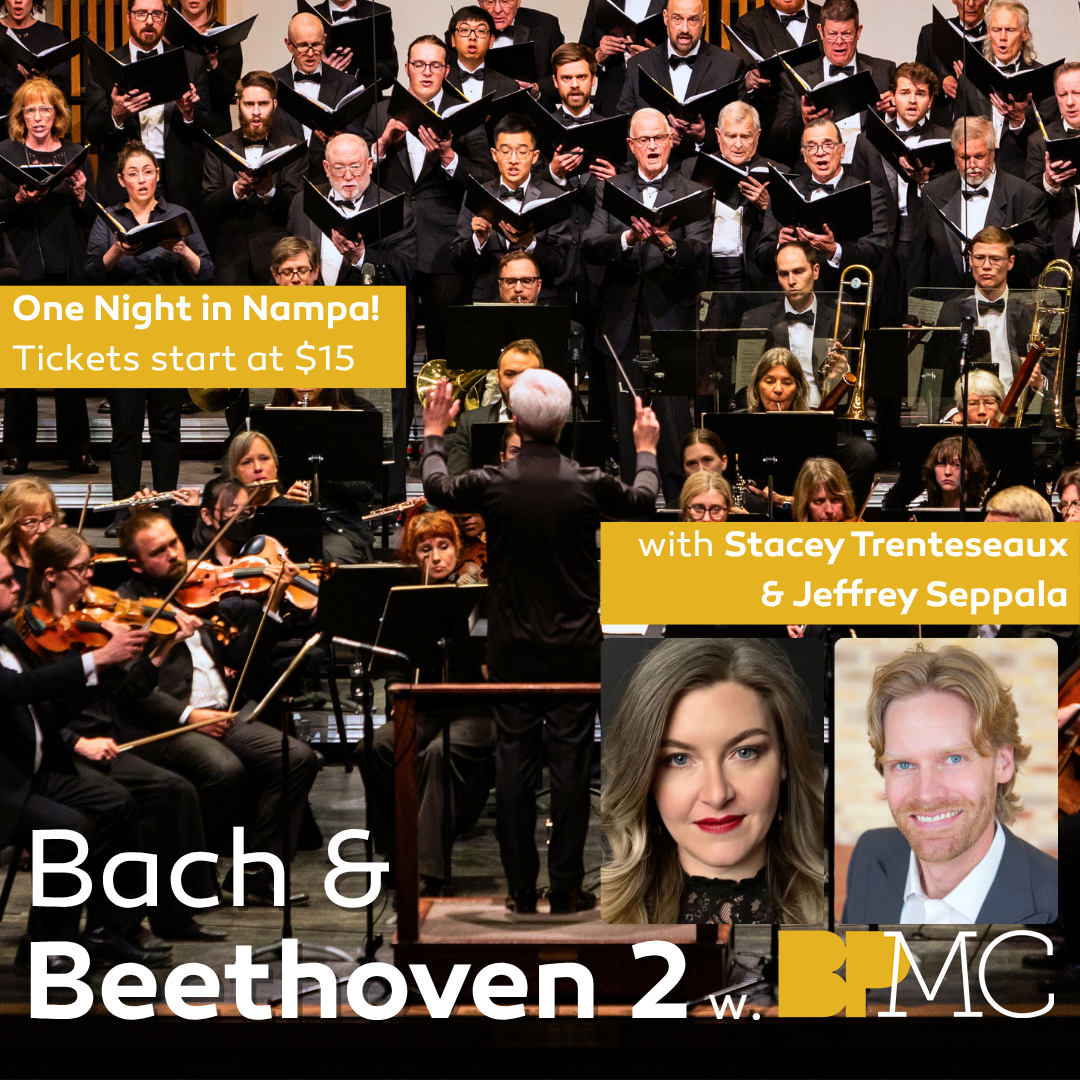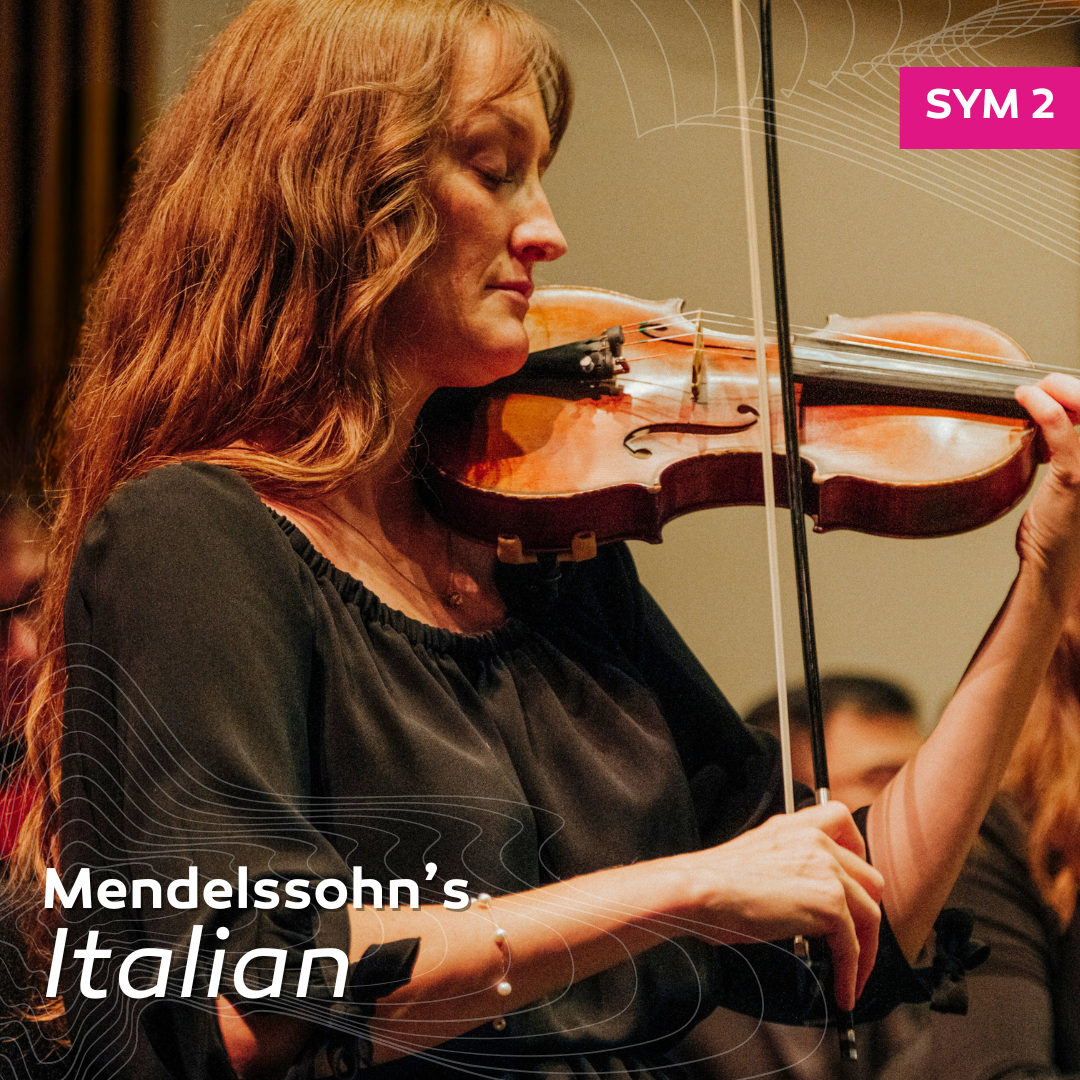BACH & BEETHOVEN
Conductors Eric Garcia and Richard Hutton
October 25, 2025
NNU’s Brandt Center
Join us for an unforgettable evening as we celebrate the Boise Phil Master Chorale’s 50th Anniversary with the music of two timeless masters. Eric Garcia and Richard Hutton conduct a program that pairs the spiritual breadth of Bach’s Sleepers Awake Cantata, BWV 140 with the youthful brilliance of Beethoven’s Symphony No. 2.
This special appearance in Nampa brings Idaho’s premier symphony and chorale to the Brandt Center Auditorium for one night only, offering a uniquely affordable way to experience live orchestral and choral music in your own community.
The performance features soprano Stacey Trenteseaux, General Director of Opera Idaho, and bass-baritone Jeffrey Seppala, Associate Professor of Voice at Boise State University, alongside the Boise Phil Master Chorale and Orchestra.
This concert marks Boise Phil’s return to NNU’s Brandt Center, bringing live symphonic music to Nampa for one night only. Tickets range from $15 to $50, making it more accessible than ever to experience Idaho’s premier orchestra in your own backyard.
Haydn Te Deum for the Empress Maria Therese
Bach Cantata No. 140 (Wachet auf, ruft uns die Stimme)
Stacey Trentesaux, soprano
Jeffrey Seppala, baritone
Boise Phil Master Chorale
Beethoven Symphony No. 2 in D major, op. 36
Program Notes:
Written by Musicologist Bradley Berg
Franz Joseph Haydn
Born: March 31, 1732, Rohrau, Austria
Died: May 31, 1809, Vienna, Austria
Te Deum in C Major
Duration: 8 minutes
Composed: c. 1799–1800
Instrumentation: Flute, 2 oboes, 2 bassoons, 2 horns, 3 trumpets, 3 trombones, timpani, strings, organ, SATB choir
While Haydn is mostly remembered as an innovator of instrumental music, vocal music made up half of the approximately 750 works he wrote. The Te Deum in C Major comes from the apogee of his career, when Haydn was in his late sixties and writing his grandest, most inventive music yet. By 1800, his recent oratorio The Creation was a continental sensation. The Austrian Empress Marie Therese (1772–1807) not only admired Haydn’s music but also once sang the soprano part in The Creation with her “pleasant but weak voice” (Haydn’s words). She promptly commissioned Haydn to write some church music for her, resulting in the C Major Te Deum.
The Te Deum (“O God”) is a 29-verse Latin text from the fourth century that praises God. It was often set to music in celebration of feast days, the consecration of new monarchs and bishops, and as a victory hymn after important battles. Haydn wrote his first Te Deum 35 years earlier using a simple orchestra of two trumpets, timpani, and strings. The comparably extravagant instrumentation for his second attempt (see above) testifies to the splendor of his royal patron and the subsequent development of his style.
The work is in three parts: fast-slow-fast. The chorus enters by boldly proclaiming an ancient chant associated with the Te Deum. All the earth, angels, apostles, prophets, and martyrs sing their praises to God. The joyous procession comes to a halt for a solemn moment (“we beg you, help your servants”). Just as suddenly as it stopped, the sunny music returns, only clouded by a brief prayer to “keep us from all sin.” Haydn’s grandiose final gesture takes shape as a double fugue, where two simultaneous melodies spin out in various combinations. The short but impressive movement ends in a blaze of shining C major.
Johann Sebastian Bach
Born: March 31, 1685, Eisenach, Germany
Died: July 28, 1750, Leipzig, Germany
Cantata No. 140 (Wachet auf, ruft uns die Stimme, “Sleepers Awake”)
Duration: ~28 minutes
Composed: 1731
Instrumentation: 2 oboes, taille (alto oboe), horn, piccolo violin, strings, continuo, soprano, tenor, and bass soloists, SATB chorus
From 1723 to 1725, Bach composed a new 30-minute cantata nearly every week for Lutheran church services in Leipzig. Bach constructed these works by taking traditional Lutheran chorales in strophic form (the same melody sung over several stanzas) and dividing the text across several movements: an opening chorus based on the hymn tune with majestically elaborated voices, a closing 4-part harmonization of the same tune, and, sandwiched in between, various arias, recitatives, and choruses that reflected the message of the weekly homily.
The resulting cantatas were musical sermons that reinforced the pastor’s words from the weekly lesson. While those spoken words have long since faded, Bach’s cantatas are still being heard and studied 300 years later.
Bach wrote the “Sleepers Awake” Cantata several years after his initial surge of productivity on the Leipzig cantatas. It is known for its incomparable quality throughout—musically, emotionally, spiritually—even by Bach’s consistently high standards. The music is based on the Parable of the Ten Virgins, which reminds the congregation to be prepared for the Day of Judgment, or Jesus’ coming. The soprano soloist represents the human soul (the virgins in the parable), the tenor provides narration, while the bass voice plays the role of Jesus (the bridegroom in the parable).
After a short orchestral introduction, the sopranos introduce the hymn tune, a simple, rising figure urging the sleepers to awake—to be vigilant and prepared for their eventual meeting with Christ. A sequence of movements then elaborates upon the message, including the famous melody of “Zion hört die Wächter singen” (Zion hears the watchmen singing). One of the many charms of Bach’s music is his engaging use of obbligato—an independent, essential instrumental line that adds color and ornamentation alongside the main line. The featured obbligato instruments in this cantata are the piccolo violin (tuned higher than a standard violin) and the oboe; listen to how they enrich the vocal soloists with melodic commentary.
As in many of Bach’s cantatas, the finale is a reprise of the hymn tune (introduced in the first movement), now in the traditional form of a four-part harmonization. With the message and its accompanying tune firmly ingrained in the churchgoers’ minds, they would have gone in peace and returned the following Sunday for Bach’s next musical homily.
Ludwig van Beethoven
Born: December 1770, Bonn, Germany
Died: March 26, 1827, Vienna, Austria
Symphony No. 2 in D Major, Op. 36
Duration: ~33 minutes
Composed: 1801–1802
Instrumentation: 2 flutes, 2 oboes, 2 clarinets, 2 bassoons, 2 horns, 2 trumpets, timpani, strings
In 1798, around age 27, Beethoven began experiencing symptoms of hearing loss. Though concerning, this did nothing to disrupt his early career triumphs: in the spring of 1800, he bested a famous virtuoso named Steibelt in a piano duel and premiered a Symphony in C major, firmly establishing himself as a reigning pianist and rising composer in Vienna. But by 1802, Beethoven’s doctor advised him to rest his ears in the peaceful rural town of Heiligenstadt in the hope that his hearing would improve. It was here that the increasingly ambitious composer spent a productive summer writing several sonatas, a ballet, and a second symphony. These were the last works he composed before embarking on a self-proclaimed “new path” beginning with the Eroica Symphony.
The Second Symphony’s hectic premiere was typical of the era. At eight in the morning on April 5, 1803, the orchestra assembled for the first time and rehearsed for much of the next nine hours before doors opened for the evening performance. Besides the underprepared performance, critics found fault with the symphony’s “wild” and “bizarre” qualities and its overuse of the “shrill” wind instruments. More progressive audiences argued that repeated listenings, combined with better-rehearsed and larger orchestras, were key to unlocking the greatness inherent in Beethoven’s music. While these are all common practices today, they were luxuries in the early 19th century.
If the Symphony No. 2 in D Major had a nickname, it would be the “Comic.” The slow introduction gradually works up momentum into a frenzied but good-natured Allegro. It frequently features one of Beethoven’s favorite techniques—a sudden emphasis known as the sforzando—which he used to rudely disrupt the regular four-beat feel of each measure. Beethoven worked especially hard on the second movement, chiseling away until his original manuscript was almost unreadable. Contemporary listeners appreciated its pleasant melody, broad scope, and the near-constant contrasts between strings and winds. In place of the traditional slow minuet, Beethoven supplied a much faster Scherzo with unexpected accents in unusual places. Most surprising of all was the finale that began with an absurd sequence: a hiccup, a sputtering trill, and an incomplete phrase. This “wildly adventurous” movement initially drew the most criticism, though many admitted its odd theme was handled with such skill that they could not complain too harshly.
















